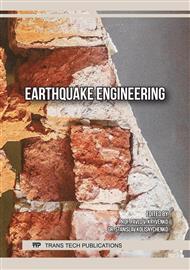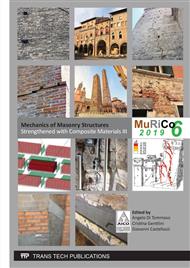[1]
Di Francesco C. (Eds.), A sei mesi dal sisma, Bologna 2014, pp.29-32.
Google Scholar
[2]
D. Ferretti; E. Coïsson, The seismic vulnerability of towers' masonry spires: learning from history, in Proceedings of the 9th International Conference on Structural Analysis of Historical Construction, (2014) - ISBN:978-3-43360-444-1.
Google Scholar
[3]
A. Lorenzelli, The seismic vulnerability of bell-towers' spires: damage analysis and modeling, thesis in Engineering, University of Parma, supervisors D. Ferretti, E. Coïsson, A.Y. 2016/(2017).
Google Scholar
[4]
M. J. DeJong, Seismic response of stone masonry spires: Analytical modeling, Engineering Structures, 40, 556-565, (2012).
DOI: 10.1016/j.engstruct.2012.03.010
Google Scholar
[5]
A. Cigada, L. Corradi Dell'Acqua, B. Mörlin Visconti Castiglione, M. Scaccabarozzi, M. Vanali, E. Zappa, Structural health monitoring of an historical building: The main spire of the Duomo di Milano, International Journal of Architectural Heritage, 1.4, 501-518, (2017).
DOI: 10.1080/15583058.2016.1263691
Google Scholar
[6]
Ministry for Cultural Heritage and Activities, Guidelines for the evaluation and mitigation of seismic risk to cultural heritage, Gangemi Editore, Roma (2008) ISBN10 88-492-1269-0.
Google Scholar
[7]
E. Zanazzi, BALANCING ON TIPTOES, Overview of the spires damaged by 2012 earthquake, georeferenced analysis and strengthening proposals, thesis in Architecture, University of Parma, supervisors E. Coïsson, D. Ferretti, B. Caselli, A.Y. 2016/(2017).
Google Scholar
[8]
Blasi C., Il consolidamento dei campanili danneggiati dal sisma: riflessioni su conservazione e sicurezza, in Di Francesco C. (a cura di), A sei mesi dal sisma, Bologna 2014, pp.230-232.
Google Scholar
[9]
Abaqus, Theory Manual, Version 6.14 (2014).
Google Scholar
[10]
G. Barbieri, L. Biolzi, M. Bocciarelli, L. Fregonese, A. Frigeri, Assessing the seismic vulnerability of a historical building, Engineering Structures, 57:523-535, (2013).
DOI: 10.1016/j.engstruct.2013.09.045
Google Scholar
[11]
M. Valente, G. Barbieri, L. Biolzi, Seismic assessment of two masonry Baroque churches damaged by the Emilia earthquake, Engineering Failure Analysis, 2017, 79: 773-802.
DOI: 10.1016/j.engfailanal.2017.05.026
Google Scholar
[12]
M. Valente, G. Milani, Non-linear dynamic and static analyses on eight historical masonry towers in the North-East of Italy, Engineering Structures, 2016, 114: 241-270.
DOI: 10.1016/j.engstruct.2016.02.004
Google Scholar
[13]
G. Castellazzi, A. M. D'Altri, S. de Miranda, A. Chiozzi, A. Tralli, Numerical insights on the seismic behaviour of a non-isolated historical masonry tower, Bulletin of Earthquake Engineering, 2017 1-29.
DOI: 10.1007/s10518-017-0231-6
Google Scholar
[14]
M. Valente, G. Barbieri, L. Biolzi, Damage assessment of three medieval churches after the 2012 Emilia earthquake, Bulletin of Earthquake Engineering, 2017, 1-42.
DOI: 10.1007/s10518-016-0073-7
Google Scholar
[15]
M. Acito, M. Bocciarelli, C. Chesi, G. Milani, Collapse of the clock tower in Finale Emilia after the May 2012 Emilia Romagna earthquake sequence: Numerical insight, Engineering Structures, 2014, 72: 70-91.
DOI: 10.1016/j.engstruct.2014.04.026
Google Scholar
[16]
G. Milani, M. Valente, Failure analysis of seven masonry churches severely damaged during the 2012 Emilia-Romagna (Italy) earthquake: non-linear dynamic analyses vs conventional static approaches, Engineering Failure Analysis, 2015, 54: 13-56.
DOI: 10.1016/j.engfailanal.2015.03.016
Google Scholar
[17]
Information on http://itaca.mi.ingv.it.
Google Scholar
[18]
I. Di Cocco, Dalla lista dei danni alla mappa del tesoro. […], in: Di Francesco C. (Eds.), A sei mesi dal sisma, Bologna 2014, pp.119-120.
Google Scholar
[19]
Castellazzi G., D'Altri A.M., De Miranda S., Ubertini F., An innovative numerical modeling strategy for the structural analysis of historical monumental buildings, Engineering Structures, 2017, 132: 229-248.
DOI: 10.1016/j.engstruct.2016.11.032
Google Scholar
[20]
R. W. Clough, J. Penzien, Dynamics of structures, McGraw-Hill, New York, (1993).
Google Scholar
[21]
L. Zanotti Fragonara, G. Boscato, R. Ceravolo, S. Russo, S. Ientile, M. L. Pecorelli, A. Quattrone, Dynamic investigation on the Mirandola bell tower in post-earthquake scenarios, Bulletin of Earthquake Engineering, 2017, 15:313-337.
DOI: 10.1007/s10518-016-9970-z
Google Scholar
[22]
S. Casolo, V. Diana, G. Uva, Influence of soil deformability on the seismic response of a masonry tower, in Bulletin of Earthquake Engineering, 2017, 15.5: 1991-2014.
DOI: 10.1007/s10518-016-0061-y
Google Scholar
[23]
S. Casolo, A three- dimensional model for vulnerability analysis of slender medieval masonry towers, Journal of Earthquake Engineering, 1998, 2(4):487-512.
DOI: 10.1080/13632469809350332
Google Scholar



